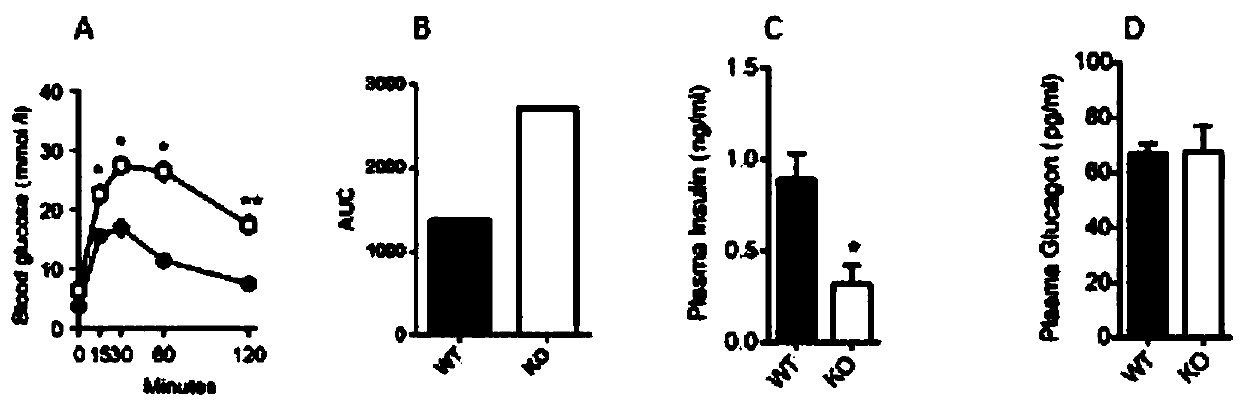Application of mTORC1 in medicines for regulating and controlling functions and conversion of pancreatic beta cells
A technology of β cells and pancreatic islets, applied in the field of diabetes
- Summary
- Abstract
- Description
- Claims
- Application Information
AI Technical Summary
Problems solved by technology
Method used
Image
Examples
Embodiment 1
[0031] Example 1, Construction of GFP-tracked β cell-specific Raptor knockout mice and GFP sorting and purification of β cells tower
[0032] In order to exclude the interference of other endocrine cells in the islets, this example constructed β cell-specific Raptor knockout GFP tracer mice. The β cell-specific Raptor knockout GFP tracer mice were constructed by the CRE-LoxP system and the Rosa26-LoxP-STOP-LoxP-EGFP system, and the purified β cells were obtained by flow sorting technology to exclude the interference of other endocrine cells in the islets.
[0033] Specifically: the currently widely used ROSA26-EGFP is adopted f mouse system. The ROSA26 gene is located on chromosome 6 of the mouse and is an antisense long-chain non-coding RNA gene, which has been shown to be expressed in most tissues and cells. A -LoxP-STOP-LoxP-EGFP-sequence is specifically inserted in this region, usually after the -STOP-sequence is transcribed, RNA synthesis will stop. The ROSA26 mice...
Embodiment 2
[0036] Example 2. Effects of β cell-specific knockout of Raptor on glucose homeostasis and β cell quality
[0037] 2.1 Raptor knockout mice had significantly elevated blood glucose at four weeks
[0038] From 2 weeks after the birth of the mice, the body weight and random blood glucose of the male mice were continuously monitored every 2 weeks, and the 6-hour fasting blood glucose of the mice was monitored from the 4th week until the mice were 12 weeks old. In this experiment, male WT mice (cre Raptor w / w g / g) as control, male knockout mouse βRapKO GFP (ere Raptor lox / lox g / g) is the experimental group. There was no difference in body weight between the two groups of mice during the observation period. At 2 weeks, βRapKO GFP The random blood glucose levels of the two groups of mice were similar to those of the WT group, and there were differences from the 4th week (12.53±0.48vs 8.72±0.17mmol / l, PGFP The blood glucose of mice in the control group continued to rise, whi...
Embodiment 3
[0046] Example 3. Changes in β-cell identity after β-cell-specific Raptor knockout
[0047] for research in βRapKO GFP Whether there is a phenomenon of transdifferentiation in mice, this example explored the 8-week-old mice.
[0048] 3.1 Changes in the properties of β cells after β cell-specific Raptor knockout
[0049] ROSA26-EGFP was used to specifically trace the mice, and the GFP-positive cells in the islets were all derived from β cells. In order to study whether β cells are transdifferentiated into α cells, this example carried out co-staining of GFP, glucagon and insulin, and found that some of the GFP-labeled β cells knocked out of Raptor expressed glucagon. We counted and found that there was no difference in the proportion of GFP- and glucagon-positive cells in GFP-positive cells at 2 weeks (WT: 0.17±0.02% vs βRapKO GFP : 0.17±0.01%). At 5 weeks, the GFP and glucagon double-positive cells in the knockout group mice were significantly increased, while the presen...
PUM
 Login to View More
Login to View More Abstract
Description
Claims
Application Information
 Login to View More
Login to View More - R&D
- Intellectual Property
- Life Sciences
- Materials
- Tech Scout
- Unparalleled Data Quality
- Higher Quality Content
- 60% Fewer Hallucinations
Browse by: Latest US Patents, China's latest patents, Technical Efficacy Thesaurus, Application Domain, Technology Topic, Popular Technical Reports.
© 2025 PatSnap. All rights reserved.Legal|Privacy policy|Modern Slavery Act Transparency Statement|Sitemap|About US| Contact US: help@patsnap.com



